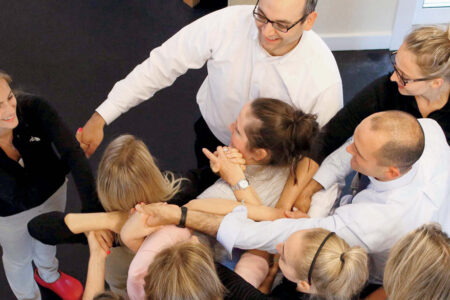On Capitol Hill
Through the years, educators at Springfield College and across the country have advocated in support of bills that would make physical education and health education on an equal level with core subjects such as math and science, and provide much-needed exercise and healthy living opportunities for youth in schools.
“Physical education and health education are the most important subjects because we will always have our human body that we want to keep healthy.”
While those efforts have been largely unsuccessful, a new bipartisan bill is looking more encouraging.
The Elementary and Secondary Education Act bill is making its way to the U.S. House of Representatives, after passing in the Senate this summer. If passed, the legislation will designate physical education and health education as core subjects and reauthorize federal funding through the Carol M. White Physical Education Program (PEP).
If the bill becomes law, it could improve the state of physical education and health education for millions of kindergarten through 12th grade students, and likely increase the need for more physical education instructors, says Tracey Dexter Matthews, G’95, DPE ’97, dean of the School of Health, Physical Education, and Recreation.
“We may see a greater interest by individuals wanting to become physical education teachers as well as bring to the forefront healthy living earlier in the lives of children,” Matthews says. “Our curriculum is very strong and this would position us to showcase that.”
Linda Davis-Delano, director of teacher preparation and certification and professor of physical education, says she hears from alumni of the program who are concerned that their schools are reducing the amount of physical education taught and are hiring people who are not fully qualified.
“What the bill would do is make it easier for our alumni to have really solid, strong programs in the schools and to make sure they are working alongside fully trained and licensed physical education and health education teachers,” she says. “It would also give them more opportunities to implement best practices in their schools and effectively meet state and national standards.”
“Physical education and health education are the most important subjects because we will always have our human body that we want to keep healthy.”
Shane Staats, PhD ’17, a doctoral student in physical education teaching and administration, was one of two people representing Massachusetts as part of SHAPE America’s Speak Out Day in Washington, D.C., in February in support of the bill. Staats presented to the staffs of Massachusetts House and Senate members. The other Massachusetts speaker was Constantine Psimopoulos, G’08, president of the Massachusetts Association for Health, Physical Education, Recreation and Dance and recipient of a Master in Education in sport and recreation management.
Staats says the focus of his talk was to dispel myths about physical education in schools.
“A lot of people are under the impression that physical education is the same thing as when they were going through school. It’s not a teacher rolling out a basketball and having recess for an hour,” Staats says. “Today’s physical education instructors are trained to provide a well-rounded physical program, and focus on important outcomes for their students.”
Staats says he emphasized that if children start earlier with consistent exercise and living a healthy lifestyle, then those efforts will benefit them later in life no matter which career path they take.
“Physical education and health education are the most important subjects because we will always have our human body that we want to keep healthy,” he says.
Supporters of the bill have argued that reducing or eliminating physical education and health education from curriculums would be detrimental to children.
“This bill is critically important to children and the future of the nation, as well as health educators. Physical education and health education have been marginalized in our society for many years,” says Michelle Moosbrugger ’00, PhD ’06, associate professor of physical education. “Currently, we don’t see those subjects in every school and every state. Not all children are getting the benefit of that experience.”
Part of the College’s physical education and health education programs teach students advocacy skills to prepare them to speak to parents and school administrators about the benefits of such programs for youth, Moosbrugger says.
Supporters of the bill have argued that there is a growing number of obese and overweight children and adolescents in schools all over the country. Sedentary behavior at such a young age could lead to similar behavior as an adult and result in medical problems and unhealthy living in the future.
An argument in favor of providing physical education programs in school includes that research shows an improvement in academics when children are more physically active.
“There is mounting evidence that physical activity has a positive impact on a child’s ability to learn to read, write, and calculate. It shows that physical activity is good for the brain and improves productivity and performance in all academic subjects,” Davis-Delano explains.
“Today’s physical education instructors are trained to provide a well-rounded physical program, and focus on important outcomes for their students.”
The PEP funding also is a critical piece of the legislation because it would enable school districts to initiate and improve their physical education curriculum, Davis-Delano says.
“The funding allows school districts to begin innovative programs or to implement a program that they would not otherwise have the money to pay for the start-up costs,” she says.
At this writing, the bill’s next stop is with education leadership from the House and Senate to come up with a compromise proposal.
For many years, Mimi Murray ’61, G’68, PhD, professor of exercise science and sports studies, has lobbied at the Statehouse and in Congress in support of legislation embedding physical education and health education as part of a well-rounded curriculum. Support from the public, educators, and organizations that strive to improve physical education programs in schools are critical to getting effective legislation passed, she says.
“We strongly encourage people to contact their Senate and Congressional leaders to express their support for such an important and necessary boost in physical education and health education,” she says. “It’s the most cost-effective health insurance we have today.”




